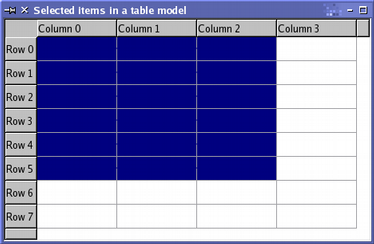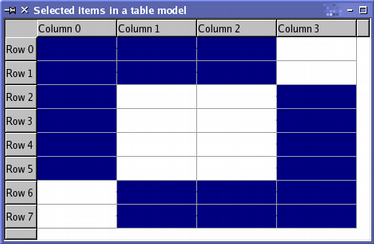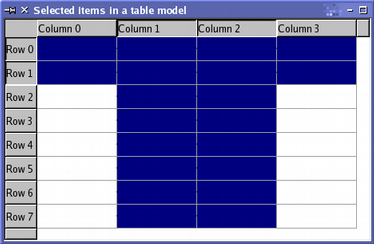Handling Selections in Item Views
|
| Current Item | Selected Items |
|---|---|
| There can only be one current item. | There can be multiple selected items. |
| The current item will be changed with key navigation or mouse button clicks. | The selected state of items is set or unset, depending on several pre-defined modes - e.g., single selection, multiple selection, etc. - when the user interacts with the items. |
| The current item will be edited if the edit key, F2, is pressed or the item is double-clicked (provided that editing is enabled). | The current item can be used together with an anchor to specify a range that should be selected or deselected (or a combination of the two). |
| The current item is indicated by the focus rectangle. | The selected items are indicated with the selection rectangle. |
When manipulating selections, it is often helpful to think of QItemSelectionModel as a record of the selection state of all the items in an item model. Once a selection model is set up, collections of items can be selected, deselected, or their selection states can be toggled without the need to know which items are already selected. The indexes of all selected items can be retrieved at any time, and other components can be informed of changes to the selection model via the signals and slots mechanism.
Using a Selection Model
The standard view classes provide default selection models that can be used in most applications. A selection model belonging to one view can be obtained using the view's selectionModel() function, and shared between many views with setSelectionModel(), so the construction of new selection models is generally not required.
A selection is created by specifying a model, and a pair of model indexes to a QItemSelection. This uses the indexes to refer to items in the given model, and interprets them as the top-left and bottom-right items in a block of selected items. To apply the selection to items in a model requires the selection to be submitted to a selection model; this can be achieved in a number of ways, each having a different effect on the selections already present in the selection model.
Selecting Items
To demonstrate some of the principal features of selections, we construct an instance of a custom table model with 32 items in total, and open a table view onto its data:
TableModel *model = new TableModel(8, 4, &app);
QTableView *table = new QTableView(0);
table->setModel(model);
QItemSelectionModel *selectionModel = table->selectionModel();
The table view's default selection model is retrieved for later use. We do not modify any items in the model, but instead select a few items that the view will display at the top-left of the table. To do this, we need to retrieve the model indexes corresponding to the top-left and bottom-right items in the region to be selected:
QModelIndex topLeft; QModelIndex bottomRight; topLeft = model->index(0, 0, QModelIndex()); bottomRight = model->index(5, 2, QModelIndex());
To select these items in the model, and see the corresponding change in the table view, we need to construct a selection object then apply it to the selection model:
QItemSelection selection(topLeft, bottomRight); selectionModel->select(selection, QItemSelectionModel::Select);
The selection is applied to the selection model using a command defined by a combination of selection flags. In this case, the flags used cause the items recorded in the selection object to be included in the selection model, regardless of their previous state. The resulting selection is shown by the view.

The selection of items can be modified using various operations that are defined by the selection flags. The selection that results from these operations may have a complex structure, but will be represented efficiently by the selection model. The use of different selection flags to manipulate the selected items is described when we examine how to update a selection.
Reading the Selection State
The model indexes stored in the selection model can be read using the selectedIndexes() function. This returns an unsorted list of model indexes that we can iterate over as long as we know which model they are for:
QModelIndexList indexes = selectionModel->selectedIndexes(); QModelIndex index; foreach(index, indexes) { QString text = QString("(%1,%2)").arg(index.row()).arg(index.column()); model->setData(index, text); }
The above code uses Qt's convenient foreach keyword to iterate over, and modify, the items corresponding to the indexes returned by the selection model.
The selection model emits signals to indicate changes in the selection. These notify other components about changes to both the selection as a whole and the currently focused item in the item model. We can connect the selectionChanged() signal to a slot, and examine the items in the model that are selected or deselected when the selection changes. The slot is called with two QItemSelection objects: one contains a list of indexes that correspond to newly selected items; the other contains indexes that correspond to newly deselected items.
In the following code, we provide a slot that receives the selectionChanged() signal, fills in the selected items with a string, and clears the contents of the deselected items.
void MainWindow::updateSelection(const QItemSelection &selected,
const QItemSelection &deselected)
{
QModelIndex index;
QModelIndexList items = selected.indexes();
foreach (index, items) {
QString text = QString("(%1,%2)").arg(index.row()).arg(index.column());
model->setData(index, text);
}
items = deselected.indexes();
foreach (index, items)
model->setData(index, "");
}
We can keep track of the currently focused item by connecting the currentChanged() signal to a slot that is called with two model indexes. These correspond to the previously focused item, and the currently focused item.
In the following code, we provide a slot that receives the currentChanged() signal, and uses the information provided to update the status bar of a QMainWindow:
void MainWindow::changeCurrent(const QModelIndex ¤t,
const QModelIndex &previous)
{
statusBar()->showMessage(
tr("Moved from (%1,%2) to (%3,%4)")
.arg(previous.row()).arg(previous.column())
.arg(current.row()).arg(current.column()));
}
Monitoring selections made by the user is straightforward with these signals, but we can also update the selection model directly.
Updating a Selection
Selection commands are provided by a combination of selection flags, defined by QItemSelectionModel::SelectionFlag. Each selection flag tells the selection model how to update its internal record of selected items when either of the select() functions are called. The most commonly used flag is the Select flag which instructs the selection model to record the specified items as being selected. The Toggle flag causes the selection model to invert the state of the specified items, selecting any deselected items given, and deselecting any currently selected items. The Deselect flag deselects all the specified items.
Individual items in the selection model are updated by creating a selection of items, and applying them to the selection model. In the following code, we apply a second selection of items to the table model shown above, using the Toggle command to invert the selection state of the items given.
QItemSelection toggleSelection; topLeft = model->index(2, 1, QModelIndex()); bottomRight = model->index(7, 3, QModelIndex()); toggleSelection.select(topLeft, bottomRight); selectionModel->select(toggleSelection, QItemSelectionModel::Toggle);
The results of this operation are displayed in the table view, providing a convenient way of visualizing what we have achieved:

By default, the selection commands only operate on the individual items specified by the model indexes. However, the flag used to describe the selection command can be combined with additional flags to change entire rows and columns. For example if you call select() with only one index, but with a command that is a combination of Select and Rows, the entire row containing the item referred to will be selected. The following code demonstrates the use of the Rows and Columns flags:
QItemSelection columnSelection; topLeft = model->index(0, 1, QModelIndex()); bottomRight = model->index(0, 2, QModelIndex()); columnSelection.select(topLeft, bottomRight); selectionModel->select(columnSelection, QItemSelectionModel::Select | QItemSelectionModel::Columns); QItemSelection rowSelection; topLeft = model->index(0, 0, QModelIndex()); bottomRight = model->index(1, 0, QModelIndex()); rowSelection.select(topLeft, bottomRight); selectionModel->select(rowSelection, QItemSelectionModel::Select | QItemSelectionModel::Rows);
Although only four indexes are supplied to the selection model, the use of the Columns and Rows selection flags means that two columns and two rows are selected. The following image shows the result of these two selections:

The commands performed on the example model have all involved accumulating a selection of items in the model. It is also possible to clear the selection, or to replace the current selection with a new one.
To replace the current selection with a new selection, combine the other selection flags with the Current flag. A command using this flag instructs the selection model to replace its current collection of model indexes with those specified in a call to select(). To clear all selections before you start adding new ones, combine the other selection flags with the Clear flag. This has the effect of resetting the selection model's collection of model indexes.
Selecting All Items in a Model
To select all items in a model, it is necessary to create a selection for each level of the model that covers all items in that level. We do this by retrieving the indexes corresponding to the top-left and bottom-right items with a given parent index:
QModelIndex topLeft = model->index(0, 0, parent); QModelIndex bottomRight = model->index(model->rowCount(parent)-1, model->columnCount(parent)-1, parent);
A selection is constructed with these indexes and the model. The corresponding items are then selected in the selection model:
QItemSelection selection(topLeft, bottomRight); selectionModel->select(selection, QItemSelectionModel::Select);
This needs to be performed for all levels in the model. For top-level items, we would define the parent index in the usual way:
QModelIndex parent = QModelIndex();
For hierarchical models, the hasChildren() function is used to determine whether any given item is the parent of another level of items.
[Previous: View Classes] [Contents] [Next: Delegate Classes]
Best Of
Actualités les plus lues
- «Le projet de loi des droits du développeur» : quelles conditions doivent remplir les entreprises pour que le développeur puisse réussir ? 93
- Thread travailleur avec Qt en utilisant les signaux et les slots, un article de Christophe Dumez traduit par Thibaut Cuvelier 1
- « Quelque chose ne va vraiment pas avec les développeurs "modernes" », un développeur à "l'ancienne" critique la multiplication des bibliothèques 103
- Pourquoi les programmeurs sont-ils moins payés que les gestionnaires de programmes ? Manquent-ils de pouvoir de négociation ? 56
- «Le projet de loi des droits du développeur» : quelles conditions doivent remplir les entreprises pour que le développeur puisse réussir ? 93
- Les développeurs détestent-ils les antivirus ? Un programmeur manifeste sa haine envers ces solutions de sécurité 32
- Qt Commercial : Digia organise un webinar gratuit le 27 mars sur la conception d'interfaces utilisateur et d'applications avec le framework 0
- Quelles nouveautés de C++11 Visual C++ doit-il rapidement intégrer ? Donnez-nous votre avis 10
- 2017 : un quinquennat pour une nouvelle version du C++ ? Possible, selon Herb Sutter 11

- Linus Torvalds : le "C++ est un langage horrible", en justifiant le choix du C pour le système de gestion de version Git 100
- Comment prendre en compte l'utilisateur dans vos applications ? Pour un développeur, « 90 % des utilisateurs sont des idiots » 231
- Quel est LE livre que tout développeur doit lire absolument ? Celui qui vous a le plus marqué et inspiré 96
- Apple cède et s'engage à payer des droits à Nokia, le conflit des brevets entre les deux firmes s'achève 158
- Nokia porte à nouveau plainte contre Apple pour violation de sept nouveaux brevets 158
- « Quelque chose ne va vraiment pas avec les développeurs "modernes" », un développeur à "l'ancienne" critique la multiplication des bibliothèques 103
- Quel est le code dont vous êtes le plus fier ? Pourquoi l'avez-vous écrit ? Et pourquoi vous a-t-il donné autant de satisfaction ? 83

Le blog Digia au hasard

Créer des applications avec un style Metro avec Qt, exemples en QML et C++, un article de Digia Qt traduit par Thibaut Cuvelier
Communauté
Ressources
- 91 cours et tutoriels Qt
- F.A.Q. Qt : 200 questions et réponses
- 51 Qt Quarterly, 35 Qt Labs et 22 Qt DevNet en français
- 43 outils Qt
- 99 sources Qt et 26 binaires Qt
- 6 livres Qt et 9 critiques
- La documentation de Qt 4.7 en français : 157 classes, 70 concepts et 24 modules
- 3 certifications Qt
Liens utiles
Contact
- Vous souhaitez rejoindre la rédaction ou proposer un tutoriel, une traduction, une question... ? Postez dans le forum Contribuez ou contactez-nous par MP ou par email (voir en bas de page).
Qt dans le magazine
| Cette page est une traduction d'une page de la documentation de Qt, écrite par Nokia Corporation and/or its subsidiary(-ies). Les éventuels problèmes résultant d'une mauvaise traduction ne sont pas imputables à Nokia. | Qt 4.6-snapshot | |
| Copyright © 2012 Developpez LLC. Tous droits réservés Developpez LLC. Aucune reproduction, même partielle, ne peut être faite de ce site et de l'ensemble de son contenu : textes, documents et images sans l'autorisation expresse de Developpez LLC. Sinon, vous encourez selon la loi jusqu'à 3 ans de prison et jusqu'à 300 000 E de dommages et intérêts. Cette page est déposée à la SACD. | ||
| Vous avez déniché une erreur ? Un bug ? Une redirection cassée ? Ou tout autre problème, quel qu'il soit ? Ou bien vous désirez participer à ce projet de traduction ? N'hésitez pas à nous contacter ou par MP ! | ||
Copyright © 2000-2012 - www.developpez.com



















